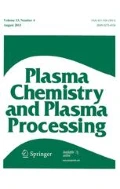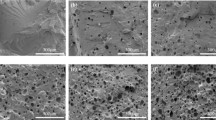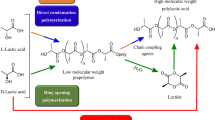Abstract
Samples of porous foam from polyurethane/urea copolymers based on polyethylene glycol (PURPEG) were prepared in the form of 1-mm-thick discs of diameter 10 cm and exposed to ammonia plasma created by inductively coupled radiofrequency discharge in either low density (E mode) or high density (H mode). The evolution of surface composition and structure upon plasma treatment was characterized by X-ray photoelectron spectroscopy. Treatment in the H mode caused depletion of oxygen even after 2 s of treatment, whereas treatment in the E mode caused gentle functionalization with amide groups. The concentration of functional groups depended on the discharge power, and the best results were obtained at moderately high power just before the transition from E to H modes.









Similar content being viewed by others
References
John MJ, Thomas S (2008) Biofibres and biocomposites. Carbohydr Polym 71(3):343–364. doi:10.1016/j.carbpol.2007.05.040
Izdebska J, Thomas S (2016) Printing on polymers: fundamentals and applications. Elsevier, Waltham
Augustine R, Rajendran R, Cvelbar U, Mozetic M, George A (2013) Biopolymers for health, food, and cosmetic applications. In: Handbook of biopolymer-based materials. Wiley-VCH Verlag, pp 801–849. doi:10.1002/9783527652457.ch27
Augustine R, Kalarikkal N, Thomas S (2014) Advancement of wound care from grafts to bioengineered smart skin substitutes. Prog Biomater 3(2–4):103–113. doi:10.1007/s40204-014-0030-y
Nair LS, Laurencin CT (2007) Biodegradable polymers as biomaterials. Prog Polym Sci 32(8–9):762–798. doi:10.1016/j.progpolymsci.2007.05.017
Ulery BD, Nair LS, Laurencin CT (2011) Biomedical applications of biodegradable polymers. J Polym Sci B Polym Phys 49(12):832–864. doi:10.1002/polb.22259
Mohanty AK, Misra M, Hinrichsen G (2000) Biofibres, biodegradable polymers and biocomposites: an overview. Macromol Mater Eng 276(3–4):1–24. doi:10.1002/(Sici)1439-2054(20000301)276:1<1:Aid-Mame1>3.0.Co;2-W
Augustine R, Dominic EA, Reju I, Kaimal B, Kalarikkal N, Thomas S (2015) Electrospun poly(ε-caprolactone)-based skin substitutes: in vivo evaluation of wound healing and the mechanism of cell proliferation. J Biomed Mater Res B 103(7):1445–1454. doi:10.1002/jbm.b.33325
Augustine R, Kalarikkal N, Thomas S (2015) Clogging free electrospinning of polycaprolactone using acetic acid/acetone mixture. Polym Plast Technol. doi:10.1080/03602559.2015.1036451
Ferreira P, Alves P, Coimbra P, Gil MH (2015) Improving polymeric surfaces for biomedical applications: a review. J Coat Technol Res 12(3):463–475. doi:10.1007/s11998-015-9658-3
Popelka A, Novak I, Lehocky M, Junkar I, Mozetic M, Kleinova A, Janigova I, Slouf M, Bilek F, Chodak I (2012) A new route for chitosan immobilization onto polyethylene surface. Carbohydr Polym 90(4):1501–1508. doi:10.1016/j.carbpol.2012.07.021
Popelka A, Novak I, Lehocky M, Chodak I, Sedliacik J, Gajtanska M, Sedliacikova M, Vesel A, Junkar I, Kleinova A, Spirkova M, Bilek F (2012) Anti-bacterial treatment of polyethylene by cold plasma for medical purposes. Molecules 17(1):762–785. doi:10.3390/molecules17010762
Asadinezhad A, Novak I, Lehocky M, Sedlarik V, Vesel A, Junkar I, Saha P, Chodak I (2010) A physicochemical approach to render antibacterial surfaces on plasma-treated medical-grade PVC: irgasan coating. Plasma Process Polym 7(6):504–514. doi:10.1002/ppap.200900132
Lehocky M, Mracek A (2006) Improvement of dye adsorption on synthetic polyester fibers by low temperature plasma pre-treatment. Czechoslov J Phys 56:B1277–B1282. doi:10.1007/s10582-006-0362-5
Augustine R, Saha A, Jayachandran VP, Thomas S, Kalarikkal N (2015) Dose-dependent effects of gamma irradiation on the materials properties and cell proliferation of electrospun polycaprolactone tissue engineering scaffolds. Int J Polym Mater Polym Biomater 64(10):526–533. doi:10.1080/00914037.2014.977900
Morent R, De Geyter N, Desmet T, Dubruel P, Leys C (2011) Plasma surface modification of biodegradable polymers: a review. Plasma Process Polym 8(3):171–190. doi:10.1002/ppap.201000153
Vesel A, Junkar I, Cvelbar U, Kovac J, Mozetic M (2008) Surface modification of polyester by oxygen- and nitrogen-plasma treatment. Surf Interface Anal 40(11):1444–1453. doi:10.1002/sia.2923
Chu PK, Chen JY, Wang LP, Huang N (2002) Plasma-surface modification of biomaterials. Mater Sci Eng R 36(5–6):143–206. doi:10.1016/S0927-796X(02)00004-9
Vesel A (2008) XPS study of surface modification of different polymer materials by oxygen plasma treatment. Inf Midem 38(4):257–265
Jacobs T, Morent R, De Geyter N, Dubruel P, Leys C (2012) Plasma surface modification of biomedical polymers: influence on cell-material interaction. Plasma Chem Plasma Process 32(5):1039–1073. doi:10.1007/s11090-012-9394-8
Garcia JL, Asadinezhad A, Pachernik J, Lehocky M, Junkar I, Humpolicek P, Saha P, Valasek P (2010) Cell proliferation of HaCaT keratinocytes on collagen films modified by argon plasma treatment. Molecules 15(4):2845–2856. doi:10.3390/molecules15042845
Gorjanc M, Mozetic M (2014) Modification of fibrous polymers by gaseous plasma: principles, techniques and applications. Lambert Academic Publishing, Saarbrücken
Kutasi K, Vasco G, Sa PA (2011) Active species downstream of an Ar–O2 surface-wave microwave discharge for biomedicine, surface treatment and nanostructuring. Plasma Sources Sci Technol 20(3):035006. doi:10.1088/0963-0252/20/3/035006
Vesel A, Kolar M, Doliska A, Stana-Kleinschek K, Mozetic M (2012) Etching of polyethylene terephthalate thin films by neutral oxygen atoms in the late flowing afterglow of oxygen plasma. Surf Interface Anal 44(13):1565–1571. doi:10.1002/sia.5064
Kregar Z, Biscan M, Milosevic S, Vesel A (2011) Monitoring oxygen plasma treatment of polypropylene with optical emission spectroscopy. IEEE Trans Plasma Sci 39(5):1239–1246. doi:10.1109/Tps.2011.2123111
Belmonte T, Bernardelli EA, Mafra M, Duday D, Frache G, Poncin-Epaillard F, Noël C, Choquet P, Migeon HN, Maliska AM (2011) Comparison between hexatriacontane and stearic acid behaviours under late Ar–O2 post-discharge. Surf Coat Technol 205(2):S443–S446. doi:10.1016/j.surfcoat.2011.03.041
Belmonte T, Pintassilgo CD, Czerwiec T, Henrion G, Hody V, Thiebaut JM, Loureiro J (2005) Oxygen plasma surface interaction in treatments of polyolefines. Surf Coat Technol 200(1–4):26–30. doi:10.1016/j.surfcoat.2005.02.108
Bernardelli EA, Mafra M, Maliska AM, Belmonte T, Klein AN (2013) Influence of neutral and charged species on the plasma degradation of the stearic acid. Mater Res 16:385–391. doi:10.1590/S1516-14392013005000008
Silva WD, Belmonte T, Duday D, Frache G, Noel C, Choquet P, Migeon HN, Maliska AM (2012) Interaction mechanisms between Ar–O2 post-discharge and biphenyl. Plasma Process Polym 9(2):207–216. doi:10.1002/ppap.201100119
Mozetic M, Primc G, Vesel A, Zaplotnik R, Modic M, Junkar I, Recek N, Klanjsek-Gunde M, Guhy L, Sunkara MK, Assensio MC, Milosevic S, Lehocky M, Sedlarik V, Gorjanc M, Kutasi K, Stana-Kleinschek K (2015) Application of extremely non-equilibrium plasmas in the processing of nano and biomedical materials. Plasma Sources Sci Technol 24(1):015026. doi:10.1088/0963-0252/24/1/015026
Zaplotnik R, Vesel A, Mozetic M (2011) Transition from E to H mode in inductively coupled oxygen plasma: hysteresis and the behaviour of oxygen atom density. EPL Europhys Lett 95(5):55001. doi:10.1209/0295-5075/95/55001
Kortshagen U, Gibson ND, Lawler JE (1996) On the E–H mode transition in RF inductive discharges. J Phys D Appl Phys 29(5):1224–1236. doi:10.1088/0022-3727/29/5/017
Lee J-K, Lee H-C, Chung C-W (2011) E–H mode transition in inductively coupled plasma using Ar, O2, N2, and mixture gas. Current Appl Phys 11(5):S149–S153. doi:10.1016/j.cap.2011.04.009
Wang J, Du Y-C, Zhang X, Zheng Z, Liu Y, Xu L, Wang P, Cao J-X (2014) E → H mode transition density and power in two types of inductively coupled plasma configuration. Phys Plasmas 21(7):073502. doi:10.1063/1.4886147
Miyoshi Y, Petrovic ZL, Makabe T (2002) Transition between capacitive and inductive mode in inductively coupled plasma observed by emission computerized tomography. IEEE Trans Plasma Sci 30(1):130–131. doi:10.1109/TPS.2002.1003958
Cunge G, Crowley B, Vender D, Turner MM (1999) Characterization of the E to H transition in a pulsed inductively coupled plasma discharge with internal coil geometry: bi-stability and hysteresis. Plasma Sources Sci Technol 8(4):576–586. doi:10.1088/0963-0252/8/4/309
Turner MM, Lieberman MA (1999) Hysteresis and the E–H transition in radiofrequency inductive discharge. Plasma Sources Sci Technol 8(2):312–324. doi:10.1088/0963-0252/8/2/312
Okigawa A, Tadokoro M, Itoh A, Nakano N, Petrovic ZL, Makabe T (1997) Three-dimensional optical emission tomography of an inductively coupled plasma. Jpn J Appl Phys 36(1):4605–4616. doi:10.1143/JJAP.36.4605
Okigawa A, Makabe T, Shibagaki T, Nakano N, Petrovic ZL, Kogawa T, Itoh A (1996) Robot assisted optical emission tomography in an inductively coupled plasma reactor. Jpn J Appl Phys 35(3):1890–1893. doi:10.1143/JJAP.35.1890
Pan J, Li G, Chen Z, Chen X, Zhu W, Xu K (2009) Alternative block polyurethanes based on poly(3-hydroxybutyrate-co-4-hydroxybutyrate) and poly(ethylene glycol). Biomaterials 30(16):2975–2984. doi:10.1016/j.biomaterials.2009.02.005
Niu Y, Chen KC, He T, Yu W, Huang S, Xu K (2014) Scaffolds from block polyurethanes based on poly(ɛ-caprolactone) (PCL) and poly(ethylene glycol) (PEG) for peripheral nerve regeneration. Biomaterials 35(14):4266–4277. doi:10.1016/j.biomaterials.2014.02.013
Kolar M, Mozetic M, Stana-Kleinschek K, Fröhlich M, Turk B, Vesel A (2015) Covalent binding of heparin to functionalized PET materials for improved haemocompatibility. Materials 8(4):1526. doi:10.3390/ma8041526
Schaber PM, Colson J, Higgins S, Thielen D, Anspach B, Brauer J (2004) Thermal decomposition (pyrolysis) of urea in an open reaction vessel. Thermochim Acta 424(1–2):131–142. doi:10.1016/j.tca.2004.05.018
Hearn MJ, Ratner BD, Briggs D (1988) SIMS and XPS studies of polyurethane surfaces. 1. Preliminary studies. Macromolecules 21(10):2950–2959. doi:10.1021/ma00188a011
Shimizu K, Phanopoulos C, Loenders R, Abel ML, Watts JF (2010) The characterization of the interfacial interaction between polymeric methylene diphenyl diisocyanate and aluminum: a ToF-SIMS and XPS study. Surf Interface Anal 42(8):1432–1444. doi:10.1002/sia.3586
Shinohara H, Nakahara A, Kitagawa F, Takahashi Y, Otsuka K, Shoji S, Ohara O, Mizuno J (2011) XPS and NEXAFS studies of VUV/O3 treated aromatic polyurea and its application to microchip electrophoresis. Nanobiotechnol IET 5(4):136–142. doi:10.1049/iet-nbt.2011.0006
Moles MD, Scotchford CA, Campbell Ritchie A (2014) Oxidation state of a polyurethane membrane after plasma etching. Conf Pap Sci 2014:347979. doi:10.1155/2014/347979
Greenwood OD, Hopkins J, Badyal JPS (1997) Non-isothermal O2 plasma treatment of phenyl-containing polymers. Macromolecules 30(4):1091–1098. doi:10.1021/ma9604202
Acknowledgments
The research was funded by Slovenian Research Agency ARRS (Project Grant No. L2-6767) and the National Science Foundation of China (NSFC Project No. 21274083) and bilateral project Bi-CN-10-01 and 10-1 (2014).
Author information
Authors and Affiliations
Corresponding author
Electronic supplementary material
Below is the link to the electronic supplementary material.

Figure S1
XPS spectrum of an untreated PURPEG sample and the calculated surface composition (JPEG 1199 kb)
Rights and permissions
About this article
Cite this article
Vesel, A., Zaplotnik, R., Primc, G. et al. Functionalization of Polyurethane/Urea Copolymers with Amide Groups by Polymer Treatment with Ammonia Plasma. Plasma Chem Plasma Process 36, 835–848 (2016). https://doi.org/10.1007/s11090-016-9696-3
Received:
Accepted:
Published:
Issue Date:
DOI: https://doi.org/10.1007/s11090-016-9696-3




